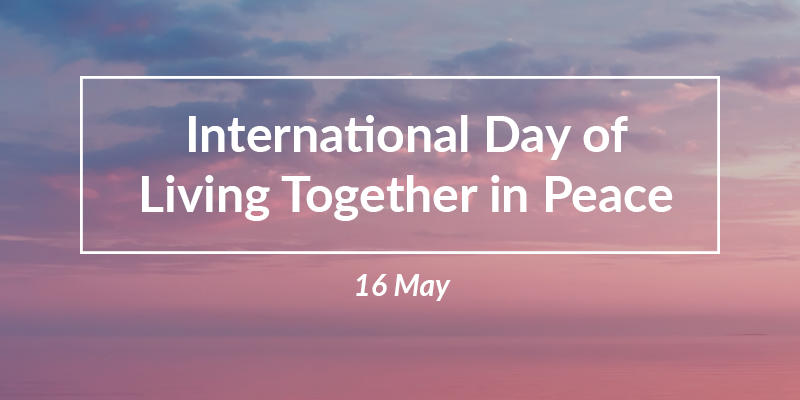
The International Day of Living Together in Peace is held on 16th May every year. The UN General Assembly, declared 16 May the International Day of Living Together in Peace, as a means of regularly mobilising the efforts of the international community to promote peace, tolerance, inclusion, understanding and solidarity. The day aims to uphold the desire to live and act together, united in differences and diversity, in order to build a sustainable world of peace, solidarity and harmony.
Living together in peace is all about accepting differences and having the ability to listen to, recognise, respect and appreciate others, as well as living in a peaceful and united way.
Following the devastation of the Second World War, the United Nations was established to save succeeding generations from the scourge of war. One of its purposes is to achieve international cooperation in solving international problems, including by promoting and encouraging respect for human rights and for fundamental freedoms for all without distinction as to race, sex, language or religion.
The declaration came about as a result of the long-held and cherished concept — contained within the Constitution of UNESCO — that "since wars begin in the minds of men, it is in the minds of men that the defenses of peace must be constructed." The Declaration embraces the principle that peace is not merely the absence of conflict, but also requires a positive, dynamic participatory process, in which dialogue is encouraged and conflicts are resolved in a spirit of mutual understanding and cooperation.
Perhaps this year more than ever we need a day like this to focus on what we can do about the plight of Ukrainians. Australia has taken some Ukrainian refugees and so the children we teach may well meet refugee children. When I suggested at school that we did need to ensure that the children we teach had some understanding of what is happening in the world without necessarily scaring them, teachers said the children were too young to know, but I agree with this quote:
‘While children should never have to be in a war, to fail to teach them about the cruelty of warfare and its horrific consequences means that they will be less prepared to make decisions about the wars waged in the future and will be less likely to be empathetic to the innocent victims of war.’
The tricky part of teaching children about war and conflict, of course, is that you want to make sure that the material is not too ‘heavy’ for their age. It is difficult to find age-appropriate books about war for very young children. However, there are several really great books about PEACE that can be used to introduce some of the same concepts and there are picture books which allow young children to empathise with refugees.
If you too are looking, try these:
A simple and colourful book that gets preschoolers and kindergarteners thinking about what peace means in terms they can understand using examples from their daily life, such as, “Peace is sharing a meal.” “Peace is sharing a meal.” “Peace is making new friends.”
A unique book where the author asked children what peace feels like, looks like, sounds like, etc. Answers were gathered from a variety of children and are fun and interesting to read.
At the beginning, the author ponders what needs to happen in order to bring peace to the world. Through successive pages, filled with poignant quotes from famous peacemakers, the story guides the reader to see how creating peace is a responsibility that we all share.
A frog finds a beautiful flower and picks it for himself. When a mouse sees him with it, his jealousy overcomes him, and he swipes it. Frog’s friends come to his aid and chase the mouse away. But before the frogs can celebrate, Mouse’s friends return for a counter-attack. Before long the conflict has devolved into a full-scale frog-mouse war. By the end of it, all either side can ask is: why? This seemingly simple book tackles an important subject and will be an invaluable way to talk to young children about conflict and warfare.
Hassan feels out of place in a new cold, grey country. At school, he paints a picture showing his colourful Somalian home, covered with the harsh colours of war from which his family has fled. He tells his teacher about their voyage from Mogadishu to Mombasa, then to the refugee camp and on to England. But gradually things change.
When a young girl has to travel to a new country and start at a new school, her Fear tells her to be alone and afraid. How can she hope to make friends if she doesn't understand their language?










Thank you for this very timely post on an important topic.
ReplyDelete